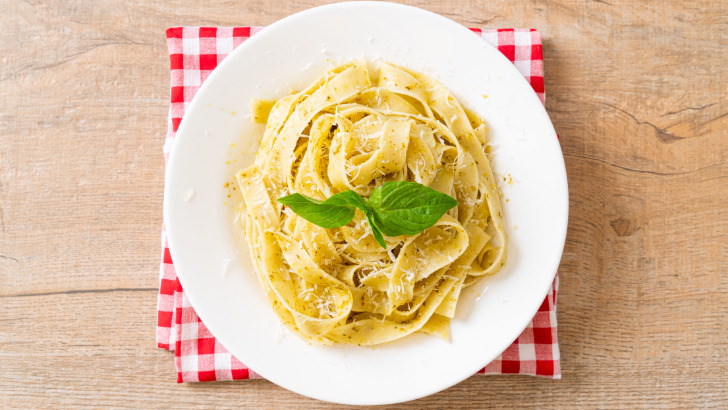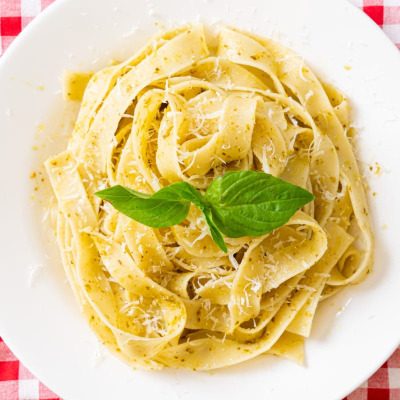Updated on April 15th, 2023
Fettuccine noodles, like any other pasta, are a versatile element that goes well with almost any spice, taste, or protein. With so many options, it’s no surprise that many evening dinners begin with noodles.
The Italians, who are experts at creating, preparing, and eating pasta, revere the process. Cooking fettuccine pasta correctly puts you in the company of some of Italy’s best chefs and the Italian moms who taught them.
Learn this excellent guide on how to cook a delectable fettuccine noodle.

Fettuccini Noodles Nutrition Facts

Tips for Cooking Fettuccini Noodles
Bringing a pot of water to a boil, dropping in the fettuccine noodles, and stirring until they’re done seems simple enough. It is important to consider whether you’re boiling fresh or dry fettuccine. Also, the amount of water you use and how well done you prefer your pasta are crucial considerations.
So many factors go into what appears to be a straightforward task.
- Fettuccine noodle’s thickness allows it to resist even the most strong sauces. You can try it with sauces that are dairy-based, oil-based, or tomato-based, as well as sauces that include meat, vegetables, fish, or cheese.
- If you desire to enhance the flavor of the pasta – that’s not a big deal – simply add a good pinch of sea salt to the cooking water.
- You should avoid putting oil in the water, and oil in the water will prevent the sauce from sticking to the pasta.
- Rinsing your cooked pasta would be counterproductive to the ultimate product of the dish recipe because the excess starch – that water will wash off – is necessary for the structure and flavor of the pasta sauce you’re making.
In reality, using pasta water instead of regular tap water in a pasta sauce is based on this logic. Since the liquid in which you cook your pasta is full of starch that the pasta has released, it’s an excellent liquid for thickening sauces.
- Fresh pasta cooks quickly and floats to the top of the water when done. However, it is necessary to taste dried pasta. Taste yours while it cooks, and when it’s to your liking, set aside a ladleful of the pasta water before draining the fettuccine. Add it right away to the saucepan that’s waiting on the side.
- If you’re creating an egg-based sauce – like alfredo or carbonara – add a ladle of water to the pan. When the pasta is added, it will prevent the eggs from curdling. You also make sure your plates are heated. Fettuccine, like other pasta, should be served hot and immediately.
- You can make fettuccine noodles ahead of time. Cook the fettuccine, then drain and mix with olive oil. You should only use oil on the fettuccine noodles in this case.
You can allow the pasta to cool before placing it in a zippered plastic bag and storing it in the refrigerator. Warm the noodles in the sauce when you’re ready to serve it and eat.
How to cook fettuccine noodles
Pick a Pot
Fettuccine noodles can be prepared in a variety of ways. Whether you use a little pot, a large pot, or a dutch oven, it all depends on what you’re cooking and how much you’re creating.
Many cooks prefer to boil pasta in a large, deep pot, and it ensures that long, thin noodles, such as spaghetti, can fully immerse straight away. However, keep in mind that the more water you have, the more salt you’ll require.
Season with salt
Keep your salt on hand. It should be added to the boiling water right before it boils because salted water takes longer to come to a boil.
After that, get ready to toss in the noodles. The first and only time you can flavor the noodles is during the boiling phase. Without it, the flavor of your pasta meal is totally dependent on the items incorporated into it.
Moreover, you don’t need to be concerned about the sodium content. The flavor of the salt is absorbed by the noodles, not the sodium concentration. For every 16 cups of water, I recommend adding 1 tablespoon of salt as a starting point -this is for a single pound of fettuccine noodles.
Bring the water to a full boil.
While it may appear that adding the noodles to the pot before the water has reached a boil is innocuous, it can result in mushy noodles.
The starches on the surface of the noodles will immediately start to fill with water. So the surfaces of the noodles will cook faster and set while the water is boiling. Instead of bursting and releasing like the surface starches, the interior of the noodle will absorb the water and rehydrate. This keeps the noodle’s structure and prevents it from becoming overly soft and mushy.
Stir the water as you initially put the noodles in
The water temperature will drop somewhat once you add the fettuccine noodles to your pot. If it came to a full boil earlier, it should rapidly return to that temperature before your noodles get mushy.
However, if you don’t stir the noodles, some of the surface starches will begin to release quickly, causing them to stick together and to the sides of the pot.
Taste the Noodles as soon as possible
Depending on fettuccine noodles, expect to cook your dry noodles for 8 to 10 minutes. Start monitoring it after four minutes, as the time will vary depending on the size of the noodle.
If you have fresh spaghetti noodles, you might just need to boil them for a minute or two, or even three minutes.
Stop cooking the noodles until they’re al dente if you’re going to put them in a casserole like a typical lasagna that will continue to cook in the oven. In addition, if you’re cooling cooked spaghetti for pasta salad, cook the noodle just past al dente to absorb more of the dressing.
How To Cook Fettuccine Noodles

Ingredients
- Fettuccine noodles
- Kosher salt
- Heavy cream
- Butter
- Freshly grated Parmesan
- Freshly ground black pepper
- Chopped parsley
Instructions
- You may cook the fettuccine noodles according to package directions in a big pot of boiling salted water.
- Drain and save roughly 1 cup of the fettuccine noodle water.
- Meanwhile, you can melt the butter and cream in a large skillet over medium heat.
- You can keep cooking until the butter has melted and the cream has started to bubble.
- Then season with salt and pepper after whisking in the Parmesan.
- You can allow 1 to 2 minutes for the sauce to thicken slightly. The sauce will be thin at first, but it will thicken as it cools and fettuccine noodles are added.
- You can now toss in the cooked fettuccine noodles until it is well coated in the sauce.
- If the sauce is too thick, you can add 1 spoonful of the leftover fettuccine noodle water at a time.
- You can serve the dish immediately and enjoy it with a parsley or basil garnish.
You can watch this video recipe to see how to cook fettuccine noodles.
Nutrition Information:
Amount Per Serving: Calories: 0Total Fat: 0gSaturated Fat: 0gTrans Fat: 0gUnsaturated Fat: 0gCholesterol: 0mgSodium: 0mgCarbohydrates: 0gFiber: 0gSugar: 0gProtein: 0g